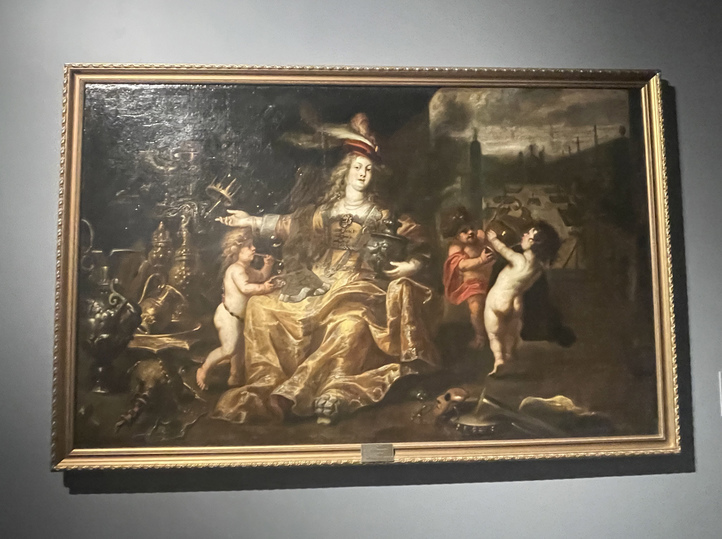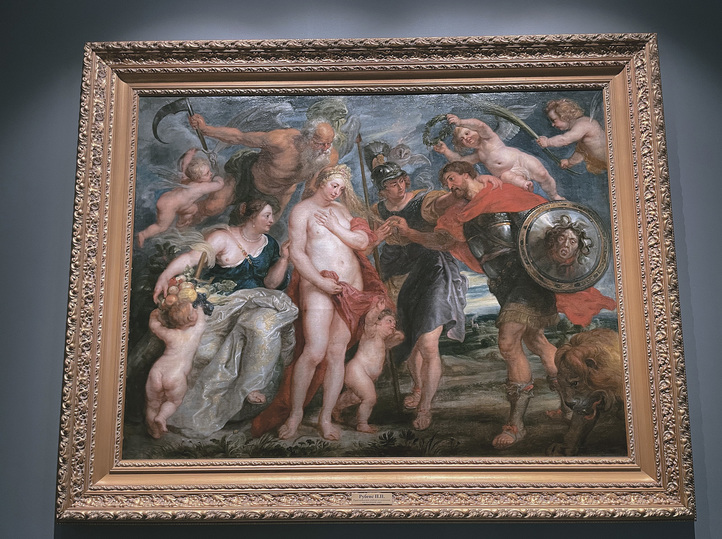Rubens signed in “New Jerusalem”
[ad_1]
At the exhibition “Under the sign of Rubens. Flemish painting of the 17th century from museums and private collections in Russia” is a double task. On the one hand, the project tells about the Baroque era, the star of which was the master of passionate, moving painting, Peter Paul Rubens. It is no coincidence that centuries later, Renoir and Van Gogh were inspired by the Flemish school – it was then that light, color, impression come to the fore. On the other hand, the exhibition introduces into scientific circulation a number of works by little-known and eminent authors of the 17th century from private and regional museum collections. For the first time, the Rubens Venuses, brilliantly restored and freshly restored, the only signed work of the master’s girlfriend Joanna Vergauven, paintings by mentors, students, and contemporaries of Rubens, were shown to the public for the first time. The exposition includes 67 paintings from 9 museum and 5 private collections. The curator of the exhibition, head of the department of art of old masters of the Pushkin Museum Vadim Sadkov is sure that some of the paintings come from the royal collections.
The 17th century is a century of pomp and pretentiousness. It is human nature to exaggerate, and in the Baroque era this quality was especially clearly manifested in art. Even still lifes are painted as if a universal drama is unfolding among fruits and vegetables. The portraits are full of pomposity and symbolism: every fold is written, every detail speaks. No house is complete without a painting. At this time, the Netherlands is experiencing a bourgeois revolution, there is an economic boom, the state becomes the first stronghold of capitalism in Europe. It is not surprising that in the cultural sense, the country is turning into a trendsetter of style. The epicenter of artistic life was Antwerp, the hometown of Peter Paul Rubens, the most populous in the Netherlands, with the highest percentage of art per capita. It is no coincidence that the exhibition presented in the “New Jerusalem” resembles a labyrinth, in the back streets of which everyday and court life of the 17th century unfolds.
The “streets” are separated from each other by gray false walls and transparent partitions with black “hieroglyphs”. These are fragments of signatures of various artists. Some of them are recognizable, like the signature of Rubens, others are completely unfamiliar. In the 17th century, it was impossible to simply call yourself an artist: you had to join a professional guild, be an apprentice for six years, and only then get permission to work independently. The workshops were not a place of solitude, but worked as workshops, where the production of painting was put on stream. This is how Peter Paul Rubens worked – after 8 years of living in Italy, he returned to his homeland, got married and opened a workshop on the busiest street in the city. The work was in full swing: the master made a sketch, agreed with the customer, then the apprentices “translated” it into the desired format, and at the final stage of glazing painting, the teacher brought the image together, did the author’s retouching. A painting painted by a master of the level of Rubens “from” and “to” with his own hand is a rarity and cost a lot of money. The artist’s heritage includes about 3,000 paintings, but not all of them are completely copyrighted. Often, students made lists (copies) of the teacher’s paintings, that is, the master did not touch them at all. So you should carefully read the explications under the works of old masters: the wording “Rubens and workshop” and “Rubens workshop” have completely different meanings.

The main sensation of the exhibition “Under the Sign of Rubens” was the reattribution of the allegorical plot dedicated to the coronation of Roxana, the captive of Alexander the Great, who became his lawful wife (the canvas is 218 by 168 cm in size). In the picture, the blonde, whose magnificent figure is barely covered by a red cape, shyly bows her head in front of the commander, who holds the crown in his hands. The plot was previously considered one of the copies of the author’s work by Rubens, versions of which are kept in the Jerusalem Museum, an English private collection and the German castle in Wörlitz. However, the project curator Vadim Sadkov is sure that “Rubens personally corrected the most important details of the composition, performed under his direct supervision by one of the assistants: these are, in particular, the images of the heads of the characters, the armor and the helmet of Alexander the Great, the precious crown in his hands, which are interpreted very vividly and artistic.” Whether the master’s hand touched Roxana is not specified, but the image fits perfectly into the concept of the “Rubensian woman”. In the lower left corner of the canvas there is a signature, made in even handwriting: “PP Rubens”. The catalog issued for the exhibition states that this work has been in the collection of George V since 1844, and since 1866 in the Museum of Hannover, until it went to auction, from where it migrated to the collection of a Russian collector in 2006.
For comparison, on the next wall is another “Rubensian Venus” – from the collection of the Prussian King Frederick II. The plot, glorifying the conclusion of peace between Spain and France, was supposed to decorate the Luxembourg Palace in Paris. Rubens received a large order for 24 canvases for the west wing and the same number for the east. However, studies say that it is unlikely that Rubens personally worked on the painting. His signature appeared on the canvas only in the second half of the 17th century, and the master died in 1640. However, the work was written earlier, in the early 1630s, so he may have directed the process. And this means that the signature “Rubens workshop” is appropriate here.
Another discovery of the project is the painting Meleager and Atalanta by Jacob Jordaens from the Yekaterinburg Museum of Fine Arts. Previously, it was believed that this is a copy. At the beginning of the 19th century, the painting was bought by Count Sheremetiev, after the revolution it ended up in the Hermitage, and during the Second World War it was evacuated along with the rest of the funds to Yekaterinburg, where it remained after. Sheremetiev bought it as the original of one of the most important masters of the Flemish school, who worked in the workshop of Rubens, but not as a student, but as a colleague. But when the work arrived at the Hermitage, for some reason it was considered a copy. Now art historians have compared the plot with other paintings by Jordaens and have come to the conclusion that it was written by his hand.
The situation is reversed with the painting “Christ and the Samaritan Woman” from the Nizhny Novgorod Museum, which lost the authorship of Jacob Jordaens. It turned out that the work has another author with the same name – Jacob Jordaens, Jr., the artist’s son, who followed in the footsteps of his parent, but did not gain fame. Only one of his works has survived – in a provincial museum in the south of France. “Christ and the Samaritan Woman” is the second. “Jordaens Jr. first worked in his father’s workshop as an assistant, and then decided to work independently – he went to Denmark, signed a contract with the Danish king. Then his traces are lost, ”Sadkov explains.

Another pictorial example of the artisanal principle in the art of the Baroque era is the Allegory painting from the Serpukhov Museum. In the 19th century, it was acquired by the collector Yuri Merlin as a work by Rubens. The painting was later attributed to an unknown artist. In the 1970s, Vadim Sadkov attributed the canvas: the figures here were painted by a student of Rubens and Jordaens, Jan Buckhorst, and the landscape and interior by Peter Buhl. “The plot reflects the theme of the exhibition as a reminder of the vanity and transience of everything earthly. It is embodied symbolically. Soap bubbles that putti blow are like missed moments. Among them, a lady who holds a metal vessel is an allusion to the myth of the beautiful Pandora, who released all the misfortunes into the world. At the last moment, she closes the box, leaving only hope. The ancient beauty here is likened to Eve – the cause of original human sin, but is revealed in the image of a modern girl of her time, ”says the curator.
Several interesting discoveries are connected with the names of women artists of the 17th century. The researchers were able to establish the only signed work of Rubens’ girlfriend Joanna Vergauwen. And also to attribute the still life “Falcon and the beaten bird”, which was previously considered the work of an unknown master of the circle, Clara Peters. During the restoration, the signature of its true author, Clara’s student Nicholas Kave, was discovered. This first known work of this master should become the standard by which it will be possible to identify his other paintings. It is also important here that workshops arose in Antwerp under the guidance of the weaker sex, despite the restrictions on women’s rights at that time.
In a word, the project turned out to be two-level. Before us is a cocktail of emotions and passions of an era when artists were not interested in reflecting reality as it is, they liked to embellish, dramatize, and carry out allegories. At the same time, it was in the 17th century that people began to think more and more about the frailty of the world – by the end of the century, art would begin to abandon lush idleness, come to the rigor and asceticism of classicism. The Baroque age left a bright mark on the history of art and even more unknown names, precisely due to the widespread guild principle of work. This second level – the study of the existence of each work – is no less, if not more interesting than the plots themselves.
Quote:
Minister of Culture and Tourism of the Moscow Region Vasily Kuznetsov:
“The State Historical and Art Museum “New Jerusalem” maintains the status of the largest regional cultural platform, acquainting residents of the Moscow region and the capital with the works of great artists. This time, the focus is on the unsurpassed Rubens and the influence of his work on his contemporaries and followers. I am sure that the exhibition will be of interest to the widest range of viewers.”
HELP “MK”
Address of the New Jerusalem Museum:
Moscow region, Istra, Novo-Ierusalimskaya embankment, 1.
Museum website: njerusalem.ru
The exhibition will be available to visitors until May 14, 2023.
For more cultural events in the region, visit welcome.mosreg.ru
[ad_2]
Source link






